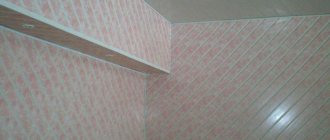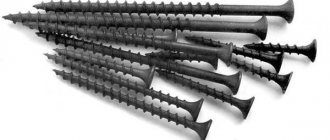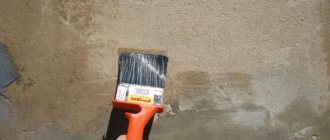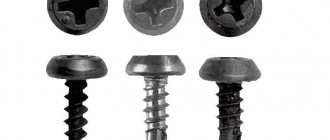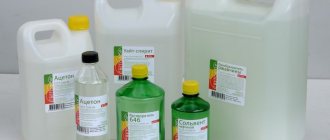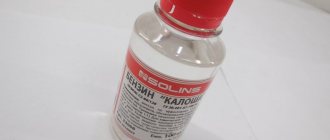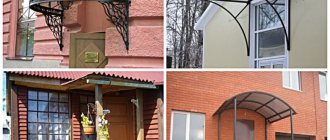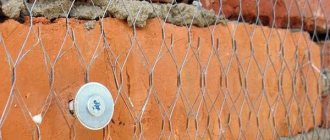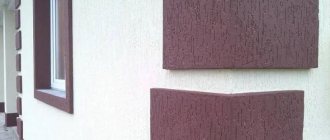The popularity of self-tapping screws in modern construction and repair is due, first of all, to the possibility of assembling a wooden structure without pre-drilling. Wood screws, due to their high hardness and strength, can be used for detachable connections of any type of wood, chipboard, plywood, MDF, fiberboard and other materials.
This article discusses design features, heat treatment options, scope of application, size table and technical characteristics of wood screws. In addition, in the relevant sections, you can find recommendations on the selection of fasteners.
Kinds
Self-tapping screws for wood, depending on the design features and operating conditions, the requirements for fasteners can vary significantly. Currently, several types of self-tapping screws are produced, which are classified according to the following criteria:
- by color and processing features;
- by thread type;
- according to the shape of the head.
Let's take a closer look at each of these categories.
Classification of self-tapping screws by color of protective coating
The following types of screws are presented in this category:
- phosphated;
- oxidized;
- chrome plated;
- galvanized;
- yellow-passivated.
Phosphated screws
Due to their affordable cost, it is phosphated self-tapping screws that are most widely used. The application of a thin phosphate coating gives the product a matte black color. Thanks to hardening, black hardware is easily screwed into soft wood, but breaks easily when bent. Another disadvantage can be considered low corrosion resistance.
Black self-tapping screws are widely used for domestic purposes, for fastening sheet materials to a wooden frame and for assembling lightly loaded structures.
Oxidized screws
The application of magnesium oxide gives the products a black color and a low gloss. The corrosion resistance of such self-tapping screws is slightly higher than that of their phosphated counterparts, but is not sufficient for use in conditions of high humidity.
The scope of application of oxidized hardware is also limited to fastening sheet materials and assembling structures operating in rooms with normal humidity.
Chrome plated screws
Chromic acid treatment ensures high resistance of chrome-plated fasteners to all types of corrosion. The surface of the screws has a characteristic silver color and metallic luster. The products are not hardened, so they can withstand significant bending and twisting loads.
Despite their resistance to corrosion, mechanical loads and aggressive environments, chrome-plated self-tapping screws are not widely used in construction and repair work due to their high cost. Such fasteners are widely used in the furniture industry and in interior decoration.
Galvanized screws
The color of galvanized self-tapping screws is determined by the type of zinc alloy with which the product is coated. Most often, silver and golden types are found. The zinc coating provides high resistance to corrosion, and the absence of heat treatment allows it to withstand significant mechanical loads.
Due to their resistance to corrosion and high mechanical strength, galvanized self-tapping screws can be used for assembling critical wooden structures operating in conditions of high humidity.
Yellow passivated self-tapping screws
In addition to applying a protective coating of zinc alloy, yellow-passivated fasteners are treated with chromic acid, which significantly increases the resistance of self-tapping screws to moisture and mechanical damage.
Yellow-passivated hardware is used in cases where, in addition to operational characteristics, the decorative component of the structure is of great importance.
Important!
When choosing fasteners, special attention must be paid to the operating conditions of wooden structures. Phosphated and oxidized hardware should not be used for external work and assembling structures that experience significant mechanical loads.
Classification of self-tapping screws by thread type
There are three types of threads that are used in the manufacture of the product:
- large thread with wide pitch;
- fine thread with frequent pitch;
- double thread.
Self-tapping screws with coarse threads
Such hardware is used for assembling structures made of wood, chipboard, plywood, MDF and other wood-based composite materials. Such threads are most often found in oxidized and phosphated black wood screws.
Self-tapping screws with fine thread
It is advisable to use fasteners with fine threads when working with hard wood and attaching sheet materials to a metal frame.
Self-tapping screws with double thread
This type of carving is much less common than the two previous varieties. Self-tapping screws with double-start threads are used for assembling structures from materials of different densities.
Important!
The strength and rigidity of the structure depends on the correct choice of thread type.
Classification of self-tapping screws by head shape
Depending on the characteristics of fastening and purpose, wood screws can be:
- with press washer;
- with hex head;
- roofing
A separate group of hardware includes confirmats - special fasteners used primarily in the furniture industry.
Self-tapping screws with press washer
There are two types of self-tapping screws with a press washer: sharp and with a drill-shaped tip.
The presence of a press washer makes it possible to ensure tight pressing of sheet facing materials to a wooden or metal frame, therefore, most often, self-tapping screws with a press washer are used for covering various structures with sheet metal, plywood, chipboard, fiberboard and other facing materials. In addition, they can be screwed into metal without pre-drilling.
Hex head screws
This type of fastener is characterized by high load-bearing capacity and high resistance to aggressive environments. Such self-tapping screws are used when assembling structures subject to significant mechanical loads. In addition, they are used for attaching heavy household and industrial appliances, air conditioners, brackets for installing audio and video equipment, etc. to load-bearing walls.
Roofing screws
A distinctive feature of roofing screws is the presence of a special rubberized washer that prevents the penetration of moisture into the place where the roofing material is attached. Such hardware can have both large and small threads. The tip is usually shaped like a drill.
As the name suggests, such hardware is used to attach roofing materials to metal or wood sheathing. In addition, roofing screws are used when installing fences made of corrugated sheets and other types of sheet metal. To give an attractive appearance and increase the corrosion resistance of fasteners, a special colored coating can be applied to the heads of roofing screws.
Confirmations
The main difference between comfirmats and other self-tapping screws is that it is impossible to use them without pre-drilling. There are special combination drills that allow you to form a hole of the appropriate configuration.
Another feature of this type of fastener is the presence of an internal hexagon in the head. Upon completion of assembly, a special decorative plug can be installed in it.
Galvanized metal-to-metal 4.2 mm. with press washer
The most common self-tapping screws for metal. As the name implies, they are used for screwing metal to metal. To be more precise, for screwing thin (no more than 0.9 mm) sheet material to an equally thin metal base. This is if without preliminary drilling, during drilling the thickness of the sheets being pulled together can increase significantly.
These self-tapping screws are available with or without a drill. Length from 13 mm. ( "bugs"
) up to 51 mm. Fine-pitch threads promote good fixation in sheet metal, and also hold well in not too loose wood and plastic. As a standard, products without a drill are designed for fastening into metal up to 0.9 mm, equipped with a drill on the tip - up to 2 mm.
Despite the fact that products with a drill according to German DIN standards are designed for screwing into metal up to 2 mm. without pre-drilling - in fact, they often break when screwed. Perhaps it all depends on the quality of the screws and on the specific manufacturer, but for metals thicker than 1.5 mm. I highly recommend pre-drilling the hole with a drill bit, more on that below.
I would also like to note that for fastening in metals thinner than 1 mm. It is better not to use self-tapping screws with a drill tip. This self-tapping screw holds weakly in thin metal. As an example, we can consider attaching a suspension to a profile when facing with plasterboard - the self-tapping screw spins and dangles. By the way, hardware with sharp tips, without a drill, should also be carefully screwed into thin profiles, being careful not to overtighten.
If there is a question of choosing between a sharp tip and a drill for universal tasks, then it is better to choose the option without a drill. All the same, with thick metal you need to pre-drill holes, and both a sharp tip and a drill fit equally well into the drilled holes. Self-tapping screws with a drill will be good, for example, for multiple screwing into 1.5 mm sheets.
Another argument in favor of the versatility of the sharp tip is that the screws are perfectly screwed into plastic dowels. But the tip with the drill goes very poorly with the dowels.
All products of this type are equipped with a slot for a PH2
(Philips).
Since the hardware is coated with a layer of zinc, they are very resistant to humid environments and do not require additional painting. In addition, galvanizing looks quite good and in many cases there is no need to cover the caps of these screws. Table of sizes and weights of galvanized 4.2mm self-tapping screws with a press washer
| Size | L length, mm | Weight 1000 pcs, kg without drill | Weight 1000 pcs, kg with drill |
| 4,2×13 | 13,0 | 1,66 | 1,85 |
| 4,2×14 | 14,0 | 1,73 | 1,87 |
| 4,2×16 | 16,0 | 1,89 | 2,05 |
| 4,2×19 | 19,0 | 2,04 | 2,26 |
| 4,2×25 | 25,0 | 2,45 | 2,61 |
| 4,2×32 | 32,0 | 2,87 | 3,05 |
| 4,2×41 | 41,0 | 3,60 | 3,71 |
| 4,2×48 | 48,0 | 3,78 | No |
| 4,2×51 | 51,0 | 3,87 | 4,10 |
In fact, in stores you may find products with different lengths. The table only shows common values. There are even screws 75 mm long, but this is rather an exception.
Marking of screws
In accordance with GOST 11625-80, which regulates the main design features of self-tapping screws, the marking of wood screws must indicate:
- nominal thread diameter, d
; - thread pitch, P
; - length, l
; - head diameter, D
; - head height, k
; - runout tolerance, ± IT14/2
; - Phillips number;
- cross-slot diameter, m
; - Phillips slot depth, h
; - depth of insertion of the caliber into the cross-shaped slot;
- thread undercut.
Thus, the marking of a self-tapping screw (self-tapping screw) version 2, with a thread diameter of 2.5 mm and a pitch of 1.5 mm, a length of 45 mm, made of material group 01, having a protective zinc coating 6 microns thick, will look like this:
Screw 2-2.5x1.5x45.01.016 GOST 11625-80
In practice, such a designation is rare; most sellers limit themselves to indicating the thread diameter and the length of the screw.
Self-tapping screw weight
Below is a list of the most common self-tapping screws.
Phosphated self-tapping screws for wood
| Length, mm | Weight of 1000 pieces, kg |
| 19 | 1,20 |
| 25 | 1,35 |
| 30 | 1,55 |
| 35 | 1,70 |
| 40 | 2,15 |
| 45 | 2,25 |
| 50 | 2,40 |
| 55 | 2,60 |
| 65 | 3,70 |
| 75 | 4,70 |
| 90 | 8,05 |
| 95 | 9,30 |
| 100 | 1,65 |
Self-tapping screws, oxidized for metal
| Length, mm | Weight of 1000 pieces, kg |
| 19 | 1,2 |
| 25 | 1,4 |
| 30 | 1,6 |
| 35 | 1,7 |
| 40 | 2,0 |
| 45 | 2,2 |
| 50 | 2,4 |
| 55 | 2,6 |
| 65 | 3,7 |
| 75 | 4,15 |
Self-tapping screws with press washer, sharp
| Length, mm | Weight of 1000 pieces, kg |
| 13 | 1,2 |
| 16 | 1,4 |
| 19 | 1,6 |
| 25 | 1,7 |
| 32 | 2,0 |
| 41 | 2,2 |
| 50 | 2,4 |
How to choose the length of the self-tapping screw
In order for the fastening of structural elements to be reliable and safe, it is necessary to select the correct length of the fastener.
When choosing the length of hardware for attaching wooden structural elements, most often they are guided by a simple rule: the self-tapping screw must go deep into the base part by a third of the height of the attached element. In other words, if the height of the attached part is 30 mm, for reliable fastening, the self-tapping screw must enter the base at least 10 mm. Simple calculations show that in this case, a self-tapping screw 40 mm long is sufficient. If the gauge length does not match the standard fastener length, the next larger size should be used.
When attaching to a permanent base, such as a concrete wall, several factors must be taken into account:
- the length of the screw should be 2 - 2.5 times greater than the height of the attached part;
- in order to ensure that the self-tapping screw does not rest against the concrete base, it is necessary to take into account the depth of the mounting hole and the length of the plastic dowel;
- it is preferable to fasten massive structural elements to a stationary base using galvanized or yellow-passivated hardware, since their load-bearing capacity is noticeably higher than that of phosphated or oxidized screws;
- For screwing into a plastic dowel, it is preferable to use self-tapping screws with a large thread pitch.
Important!
When connecting structural elements, self-tapping screws should not pass through; this not only contributes to the appearance of cracks, but can also lead to serious injuries.
Installation method
Installation is carried out using a Phillips screwdriver or a screwdriver with a PZ-1, 2, 3 bit based on the dimensions. If fastening is carried out in a solid material, it is recommended to first drill a hole for the self-tapping screw.
- Related products: screwdrivers, bits, plastic dowels, perforated fasteners.
- Other options for self-tapping screws: self-tapping screws with a press washer (sharp), self-tapping screw for gypsum plasterboard, confirmat screw (euro screw), self-tapping screws for sandwich panels, etc.
For wholesale orders over 15,000 rubles, courier delivery in Moscow is FREE . Transport companies deliver orders to the regions of the Russian Federation. We have minimum retail prices for our entire range of products. 8 [email protected]
Delivery is carried out throughout the Russian Federation
The cost of delivery within Russia consists of 2 amounts: 900 rubles. delivery to the terminal + cost of services of the selected transport company.
What is the difference between self-tapping screws for wood and metal?
Considering the fact that the density of wood is significantly less than the density of metal, for more reliable fastening, wood screws are produced with a wide thread pitch. The high strength of the metal makes it possible to achieve a reliable connection even with small thread pitches.
Another difference is that some types of metal screws have a tip in the form of a drill, which allows you to screw hardware, without pre-drilling, not only into a tin profile, but also into steel structural elements.
Areas of use
This type of universal screw is designed for joining wood, particle boards, plasterboard, thin sheet metal and other materials. It is distinguished by the high quality of the material used for its production, as well as wider and sharper threads.
- installation of lightweight structures made of wood, fiberboard, chipboard, plywood, plastic, plasterboard and other soft building materials;
- furniture manufacturing and assembly;
- installation of window and door fittings;
- fastening of electrical products.


